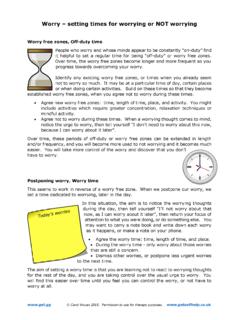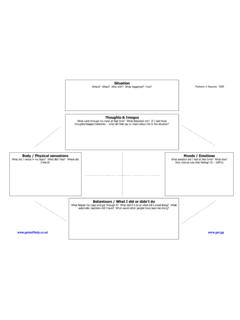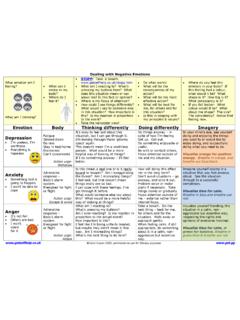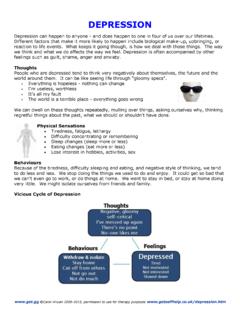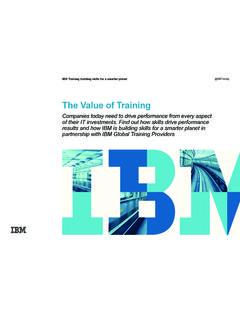Transcription of Training Our Minds in, with and for Compassion An ...
1 Training Our Minds in, with and for Compassion An Introduction to Concepts and Compassion -Focused Exercises Written by Paul Gilbert PhD FBPsS. In consultation with Drs Christine Braehler, Michelle Cree, Corinne Gale, Chris Gillespie, Ken Goss, Andrew Gumley, Chris Irons, Deborah Lee, Ian Lowens, Allison Kelly, Russell Kolts, Dennis Tirch, Mary Welford, Alistair Wilson and Choden P. Gilbert 2010. 1. Contents Section One Training Our Minds in Compassion : The Basic Model and Challenge number 1 - Dealing with our complex Challenge number 2 - Just finding ourselves here ..8. Understanding Motives and What about positive emotions? What functions do they have?.. 11. Some key questions for us to ponder .. 12. The importance of 12. Emotional Learning and Body Memories.
2 13. The Problems with Protection and Safety Strategies .. 14. The Three Circles Model: The Interactions between Different Types of Emotion .. 16. 1. Threat and Self-protection System:.. 16. 2. Incentive and Resource-seeking System .. 17. 3. Soothing and Contentment System: .. 18. Emotions about Emotions .. 19. Positive emotions can be difficult .. 19. Balancing our emotions ..20. The Many Parts of You .. 20. What is Compassion ? .. 22. The attributes and qualities of The skills of Compassion ..23. Warmth and kindness ..24. How Will Teaching Myself to be Compassionate Help Me? .. 26. Fear of 26. How our Thoughts and Images Affect our Minds and Brains .. 27. The power of The power of self-kindness ..29. Key Messages .. 30. Section Two Compassion : The Exercises.
3 32. Starting your Attention .. 33. Mindfulness .. 34. Mindfulness, attention and Mindfulness and Mindfulness and Soothing Rhythm Breathing .. 37. Exercise 1: Soothing Rhythm Breathing ..38. Simple body scan and relaxation .. 39. Exercise 2: Simple body scan and Compassion Focused Imagery Work .. 42. Some key Wandering mind ..42. 2. No clear Safe place and compassionate colour imagery ..43. Exercise 3: Creating a Safe Place ..43. Exercise 4: Compassionate Colour(s) ..44. Developing the Compassionate 44. Recognising the different parts of you ..44. The compassionate Exercise 5: The Compassionate Self ..46. Compassion under the duvet ..47. You at your best ..47. Exercise 6: Compassion Flowing Focusing the Compassionate Self .. 48. Exercise 7: Focusing the compassionate self on Exercise 8: Compassion flowing into oneself: Using Contrasting memories.
4 49. Exercise 9: Focusing the Compassionate Self on Exercise 10: Creating a Compassionate Ideal .. 51. The Skills of 52. Compassionate Attention, Thinking, Behaviour and Compassionate Thinking ..53. Changing self-criticism to compassionate self Distancing and Wise Observing ..56. Breaking identification with ones Compassionate Letter Writing .. 58. Compassionate self ..59. Compassionate Guide to your letter 61. Getting Recognising Emotions .. 62. Compassionate Behaviour .. 65. Practice and Practice Diaries .. 65. Fear of, and Blocks to, 66. Summary .. 68. Appendix .. 70. Worksheet for building your compassionate 71. Compassion Focused Thought Balancing Example Sheet ..72. Compassion Focused Thought Compassion Practice Diary Example Compassion Practice Diary.
5 76. Recommended Reading and Further Information .. 77. Handouts .. 79. 3. Section One Training Our Minds in Compassion : The Basic Model and Principles Introduction This booklet has been written for those who may be working individually with a Compassion focused therapist or in a group. It can also be used by people who want to know more about the Compassion focused approach for helping with difficult emotions and tendencies to be self-critical. More detailed writing on the Compassion focused approach can be found in Paul Gilbert's book The Compassionate Mind'. This booklet is split into two sections. The first section offers an outline of a basic approach to thinking about the nature of, and value of, developing Compassion in our lives. The second section explores some exercises that you can practise to try to stimulate your own compassionate mind.
6 First we will outline the basic model and approach to Compassion that we will be following. This will explore how our brains work and what we mean by Compassion . Now, of course, Compassion Training has been around for a long time, especially in Buddhist traditions, but here it is linked to some new ideas about how our brains work. We are going to start by looking at a couple of challenges that life presents us with and that we all experience. Challenge number 1 - Dealing with our complex brains I think many of us sort of realise' that we have a very complex and difficult brain to deal with. For example, we know that many of our difficult emotions and much of our suffering occurs because of how we feel in our bodies and in our Minds . Most of us would rather feel happy than suffer and yet, even though we know it's our emotions and moods that are a source of our suffering, we can find it very difficult to steer our emotions and moods to feeling happier.
7 Now, there are many ways we can deal with this problem. One is just to carry on and hope that things improve. Another is to try to understand our Minds better and see if we can train them and cultivate them so that our unpleasant emotions are easier to regulate, and our positive and pleasant emotions are easier to generate. A first step on this journey is to understand why our emotions can be so difficult and why this is not our fault. So let's begin to explore these questions. Now, one of the main reasons that we have a difficult and complex brain with a range of powerful emotions and urges is because of the way 4. our bodies and brains have evolved over many millions of years. For example, think about physical pain. We can experience pain if we get a headache, break a leg, or suffer from some major illness.
8 Pain is part of our body's natural defence systems it is there to alert us to things that might be wrong in the body that we need to pay attention to. Our capacity to feel pain is part of our evolved bodies and we share this with many other animals even though at times it can be severe, excruciating and cause us major difficulties in life. As we have come to understand how pain was designed', what it is for, and how it works in us, we have learned how better to regulate it. The same is true with difficult emotions such anxiety, anger or depression. This means that first we need to understand them, how they were designed by nature, for what purpose, and how they now work in us. This gives us an opportunity to then stand back from our motives and desires and recognise that these along with various emotions can flow through us, and affect how our body feels, in part because nature has designed them in a certain way.
9 Let us more look more deeply into why we are motivated to do certain things and why we can feel certain emotions. Understanding ourselves better is the first step on the journey to being compassionate with ourselves. We start with something that is not commonly recognised. That is the fact that we actually have two different types of brain in our head (some researchers even suggest we have three or four different types of brain!). How is that? Well we have an old brain that evolved many millions of years ago that does very similar things to other animals' brains. Indeed, for a moment, consider other animals and our relationship and connections to them. We have all emerged as part of the flow of life on this planet - we come from the same roots and stock' as it were.
10 If we look at other animals such as rats and monkeys, and even some of those who live in the sea, such as dolphins, we can see they are motivated to achieve similar things as we are. First there are various physical things such as trying to keep safe and out of harm's way, finding enough food, not getting too hot or too cold. Many animals will, just like us, build places to live in okay, there is a big difference between building a nest in a tree and building a four bed-roomed house! But being motivated to create a shelter and live in it is something that we share with many other animals. Second, many of our social behaviours and desires also have similarities with other animals. For example, we can observe them fighting and challenging each other for status and social position, having conflicts and making enemies, having sexual relationships, forming close friendships and bonds, caring for their children, answering distress calls, and clinging to each other when frightened.


